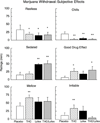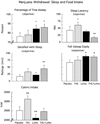Effects of THC and lofexidine in a human laboratory model of marijuana withdrawal and relapse
- PMID: 18161012
- PMCID: PMC3372576
- DOI: 10.1007/s00213-007-1020-8
Effects of THC and lofexidine in a human laboratory model of marijuana withdrawal and relapse
Abstract
Introduction: Individuals seeking treatment for their marijuana use rarely achieve sustained abstinence.
Objectives: The objectives of the study are to determine if THC, a cannabinoid agonist, and lofexidine, an alpha(2)-adrenergic receptor agonist, given alone and in combination, decreased symptoms of marijuana withdrawal and relapse, defined as a return to marijuana use after a period of abstinence.
Materials and methods: Nontreatment-seeking, male volunteers (n = 8), averaging 12 marijuana cigarettes/day, were maintained on each of four medication conditions for 7 days: placebo, tetrahydrocannabinol (THC) (60 mg/day), lofexidine (2.4 mg/day), and THC (60 mg/day) combined with lofexidine (2.4 mg/day); each inpatient phase was separated by an outpatient washout phase. During the first three inpatient days, placebo marijuana was available for self-administration (withdrawal). For the next 4 days, active marijuana was available for self-administration (relapse). Participants paid for self-administered marijuana using study earnings. Self-administration, mood, task performance, food intake, and sleep were measured.
Results: THC reversed the anorexia and weight loss associated with marijuana withdrawal, and decreased a subset of withdrawal symptoms, but increased sleep onset latency, and did not decrease marijuana relapse. Lofexidine was sedating, worsened abstinence-related anorexia, and did not robustly attenuate withdrawal, but improved sleep and decreased marijuana relapse. The combination of lofexidine and THC produced the most robust improvements in sleep and decreased marijuana withdrawal, craving, and relapse in daily marijuana smokers relative to either medication alone.
Conclusions: These data suggest the combination of lofexidine and THC warrant further testing as a potential treatment for marijuana dependence.
Figures




Similar articles
-
Marijuana withdrawal in humans: effects of oral THC or divalproex.Neuropsychopharmacology. 2004 Jan;29(1):158-70. doi: 10.1038/sj.npp.1300310. Neuropsychopharmacology. 2004. PMID: 14560320 Clinical Trial.
-
Nabilone decreases marijuana withdrawal and a laboratory measure of marijuana relapse.Neuropsychopharmacology. 2013 Jul;38(8):1557-65. doi: 10.1038/npp.2013.54. Epub 2013 Feb 26. Neuropsychopharmacology. 2013. PMID: 23443718 Free PMC article.
-
Effects of baclofen and mirtazapine on a laboratory model of marijuana withdrawal and relapse.Psychopharmacology (Berl). 2010 Aug;211(2):233-44. doi: 10.1007/s00213-010-1888-6. Epub 2010 Jun 3. Psychopharmacology (Berl). 2010. PMID: 20521030 Free PMC article. Clinical Trial.
-
Effects of smoked marijuana in healthy and HIV + marijuana smokers.J Clin Pharmacol. 2002 Nov;42(S1):34S-40S. doi: 10.1002/j.1552-4604.2002.tb06001.x. J Clin Pharmacol. 2002. PMID: 12412834 Review.
-
Lofexidine, an {alpha}2-receptor agonist for opioid detoxification.Ann Pharmacother. 2010 Feb;44(2):343-51. doi: 10.1345/aph.1M347. Epub 2009 Dec 29. Ann Pharmacother. 2010. PMID: 20040696 Review.
Cited by
-
CB1 positive allosteric modulation attenuates Δ9-THC withdrawal and NSAID-induced gastric inflammation.Pharmacol Biochem Behav. 2019 Feb;177:27-33. doi: 10.1016/j.pbb.2018.12.009. Epub 2018 Dec 28. Pharmacol Biochem Behav. 2019. PMID: 30597181 Free PMC article.
-
Treatment of Cannabis Use Disorder: Current Science and Future Outlook.Pharmacotherapy. 2016 May;36(5):511-35. doi: 10.1002/phar.1747. Pharmacotherapy. 2016. PMID: 27027272 Free PMC article. Review.
-
Preclinical Studies of Cannabinoid Reward, Treatments for Cannabis Use Disorder, and Addiction-Related Effects of Cannabinoid Exposure.Neuropsychopharmacology. 2018 Jan;43(1):116-141. doi: 10.1038/npp.2017.193. Epub 2017 Aug 28. Neuropsychopharmacology. 2018. PMID: 28845848 Free PMC article. Review.
-
Evidence from Human Studies for Utilising Cannabinoids for the Treatment of Substance-Use Disorders: A Scoping Review with a Systematic Approach.Int J Environ Res Public Health. 2023 Feb 24;20(5):4087. doi: 10.3390/ijerph20054087. Int J Environ Res Public Health. 2023. PMID: 36901098 Free PMC article.
-
Rimonabant-induced Delta9-tetrahydrocannabinol withdrawal in rhesus monkeys: discriminative stimulus effects and other withdrawal signs.J Pharmacol Exp Ther. 2010 Jul;334(1):347-56. doi: 10.1124/jpet.110.168435. Epub 2010 Apr 7. J Pharmacol Exp Ther. 2010. PMID: 20375197 Free PMC article.
References
-
- Ajilore O, Stickgold R, Rittenhouse CD, Hobson JA. Nightcap: laboratory and homebased evaluation of a portable sleep monitor. Psychophysiology. 1995;32:92–98. - PubMed
-
- Anggadiredja K, Yamaguchi T, Tanaka H, Shoyama Y, Watanabe S, Yamamoto T. Prostaglandin E2 attenuates SR141716A-precipitated withdrawal in tetrahydrocannabinol-dependent mice. Brain Res. 2003;966:47–53. - PubMed
-
- Anthony JC. Comparative epidemiology of dependence on tobacco, alcohol, controlled substances and inhalants: basic findings from the National Comorbidity Survey. Exp Clin Psychopharmacol. 1994;2:244–268.
-
- Balerio GN, Aso E, Berrendero F, Murtra P, Maldonado R. Delta9-tetrahydrocannabinol decreases somatic and motivational manifestations of nicotine withdrawal in mice. Eur J Neurosci. 2004;20:2737–2748. - PubMed
-
- Bearn J, Gossop M, Srang J. Accelerated lofexidine treatment regimen compared with conventional lofexidine and methadone treatment for inpatient opiate detoxification. Drug Alcohol Depend. 1998;50:227–232. - PubMed
Publication types
MeSH terms
Substances
Grants and funding
LinkOut - more resources
Full Text Sources
Other Literature Sources
Medical

